A Paipo Interview with Peter Kidman
April 11 and 12, 2011. Terranora, NSW (Australia)
Telephone interview by Bob Green
Peter is the father of Andrew Kidman and great grandson of Captain
William Frazer Milne, the Arctic whaler who assisted Amundsen in finding the
North-West passage. He has lots of projects on the boil including one
to enhance the number of indigenous teachers, doctors and nurses. However, this
interview is about Peter surfing in the late-1950s on a curved,
shaped board with a set of handlebars mounted on the front.
|
1. How old were you when you
began first riding a bellyboard?
About 12, I suppose.
What year was that?
I was born in 1942. So, around 1954.
Peter in 2011,
and as a younger lifesaver (second from left).
Photo by Bob Green (left) and excerpt from: North Cottesloe Surf Life Saving
Club. (2003). The History of the North Cottesloe Surf Life Saving Club. Cottesloe,
W.A.
2. Where were you in 1954?
In Perth. The surf in Perth is pretty ratshit because Rottnest is in
the way. We could catch waves in Winter.
This is pre-surfboard stuff. They were just starting to come. The first
ski I ever went on was a canvas one. From that bloke I learnt how to
fish on skis. When we lived at Mackerel Beach I had a couple of skis
that I went down the Murray on a few times. I'd trail a line off the
back and get all the taylor and salmon that I wanted.
Peter on his ski going down the Murray River - 1992.
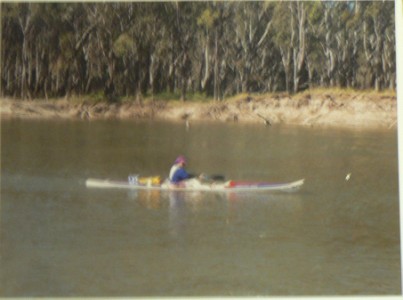
Photo courtesy Peter Kidman.
In Summer the only place we could get surf at North Cottesloe was on
this reef. That's why we had these bellyboards. Because the board would
hit the reef before we would. It was underneath us, so that's how it
all started. We'd just grab bits of wood and away we'd go.
But then a fellow called Don Bancroft, he ended up a very good jazz
player when he came over here. He was a legendary sort of fellow who
liked mucking round with wood. So he got some 3-ply and then he put a
bend in it. He heated it up and put a curve in it. Then he put a keel on
it.
3. Where did Don Bancroft get the idea of bellyboards
from?
He was trying to make a cut-out female body. He sort of had the hips
and chest and then he went round. Then he thought, "Shit I can use this
as a bellyboard." He used to just muck around with things. He didn't
put the legs on it. That's how he started.
Outline of Peter's bellyboard.
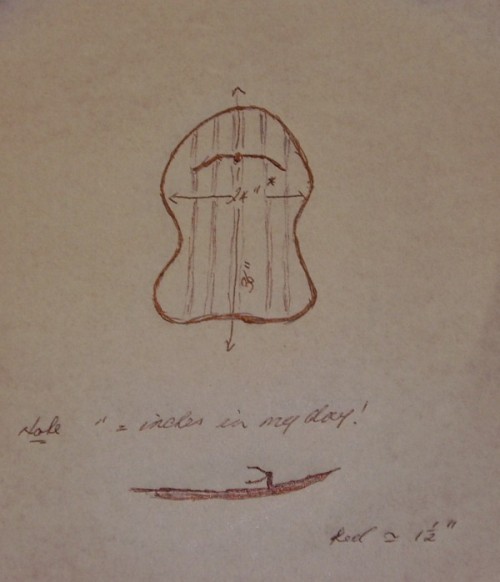
Drawing courtesy of Peter
Kidman.
So it had a fin on it?
No. It was an inch keel that went from the top to the back of it. That
held the curve in it.
The keel went the length of the board?
Then we realised if we could put some handlebars on the front of it, we
were further away from the rocks but we could plane on them. So you
could be on a wave in deep water and come back onto the rocks and you
weren't going to get killed, you had this board underneath you.
4. How were the handlebars fitted to the board?
He made a plate -- he was a pretty handy kid. He made a plate then welded
them on.
What sort of handlebars were they?
They were like the handlebars of a scooter. Like a t-bar. There were
bikes around in those days that had that type of handlebar. We only had
back-pedal brakes, we didn't have brakes on the handlebars or anything
like that. They were like motorbike handlebars. You just welded them on.
They would have weighed the nose down a bit?
Not really. They were hollow. We had flippers.
Would you steer with the handlebars or lean on them?
How would you use them to plane and turn?
You pushed down on them, lifted your chest up and your body seemed to
plane and then you can spin it around underneath you on the wave. We'd
be on an angle as we were angling away from the reef.
Could you cut back?
Yes, you'd just turn the handle.
Where was your body in relation to the board.
The back of the board was about in line with your waistline.
So your head would be over the handle bars.
Yes, you've got to remember I was only a kid. The curve at the front
was so it wouldn't nose dive.
5. How much curve was there?
Not much.
6. What shape were the boards?
How we came up with the shape - they looked like the shape of a woman's
body.
Like a peanut?
Round at the top, came in like a woman's waist and then it went out
like a tail. You sort of sat in that area. You lie on these boards and
you just kicked out. Like the modern boards, but I see kids down there
on boards today and I say, "Geez, you buy your boards. You should go out
and learn to make them. Put handlebars on them and then you can plane
on them."
7. How many guys were riding these boards?
Only my mates in the surf club riding our reef.
Don wasn't in the surf club. About four of us had them. They were
identified by the colours.
They used to have these rubber boards that you could hire from the
local shop. The pump up type. We'd never rented them, we'd pinch them
when the kids would fall off them. You'd lose them before the half hour
was up because we couldn't return them as they weren't hired in our
name.
8. Which Perth beach was this?
North Cottesloe. Eric Street used to be quite good. The reef went all
the way from Cottesloe all the way to Eric Street. The surf would come
either side of the reef. It's changed a lot because there used to be an
old jetty but they blew it up and put in a groin. The groin worked ok
but it covered everything in sand. The surfboats even used to catch the
waves on the reef. They couldn't do that today with the amount of sand.
Two views of
the reef off Eric Street, North Cottesloe Beach.
|
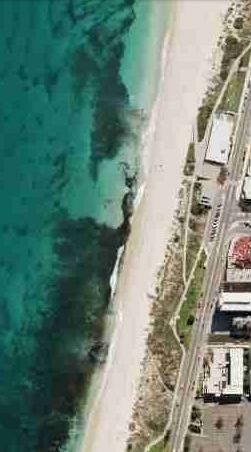
|
|
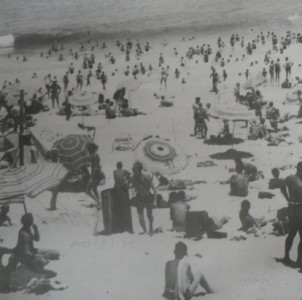
|
Source: Google Maps, 2011, and excerpt from: North Cottesloe Surf Life
Saving Club. (2003). The History of the North Cottesloe Surf Life Saving Club. Cottesloe,
W.A.
9. How long did you ride the boards for?
All the time I was a kid. I started swimming at 16. Then I started
paddling skis and stuff like that then. It was only a small group of
guys that had these. I used to be in Melbourne and my father died and my
mother ended up at the Brewery, that's why we moved here. A couple of
carpenters at the brewery made the boards for us for Christmas. They
painted them in our footy colours. I had a blue and gold striped one
(Claremont). Another kid had a black and white one.
10. How did they come to make the boards?
They had a workshop at the brewery and everything like that. They had a
paint shop because I remember when my mother got a car she didn't like
the colour so they repainted her car for her.
They were handy at the brewery?
The boss of the brewery was also my guardian because my dad had died. I
had pretty good connections. We used to get kegs of ginger beer. She
would have said, "Could someone make the boards for them?" My best mate,
Jerry Knowles, would sneak down and steal the board.
This is a good story. One of the blokes who used to coach our footy
team, that would have been under-13. I would have been 11 or 12. Ray
had a truck and we put the surfboats on the back of his truck to start
with. And he had an old canvas ski. He would let us use the canvas ski,
but Jerry would come over and inch that too. The bloody thing would
leak and sink. So we had to get the bastard from the bottom. In the end
he joined us and became one of our mates. It was a great group of kids
11. This wasn't before the Bancroft boards?
No, this was as a result of them. The blokes at the brewery made them
for us based on what Don had built. Don was a couple of years older than us.
He always wanted to be a pilot but he failed the exams. He was an
amazing bloke and a great trumpet player. When they discovered
Yallingup, not Margaret River, Yallingup came first. Donny and some of
these surfboard guys (they were just starting to make surfboards then)
they would all be camping in the hills and stuff. If you heard the
trumpet playing in the morning that would be Donny playing the trumpet
because he knew the surf was up.
Later they used to take the surfboat down there because we wanted
waves. I had to go down there because I was the vice-captain of the
club and I had to go down there and keep an eye on them. I spent most
of the time sitting under the sweep. If we sunk, I used to have an old
belt in the front of the boat. I had to swim that into shore and we'd
bring the boat in. We'd empty it out and out we'd go again. It was good
fun. You could take your bellyboards down there. You'd kick them on
with your flipper and it was even better on those huge waves. You'd be
pushing down on the handlebars and you'd be planning.
12. I'd heard they used to have ply bellyboards around
Scarborough?
They could have done. I met a guy from Scarborough who I used to swim
with and I think he could have had one. They didn't have the reefs.
They weren't as protected from Rottnest as we were. We basically had
the bellyboards to surf on the reef. They didn't wash away, they'd
always stay around. You'd find them - they floated.
Triggs was another place you could ride them. There was definitely surf
up there and the boats used to go there. The boats would go through the
surfboard riders. Bellyboards were good up there too. It was more
exposed to the south-westerly and north-westerly in winter.
On a different note, did you ever see the Vidler
bellyboards? Don Vidler made them?
Ken Vidler was in our swimming squad. So that's how he got to know about
bellyboards. I'm sure he would have seen our bellyboards. Ken was
fantastic. He was the best ironman over here for many years. [See Note 1 for additional information.]
Vidler boards.
|
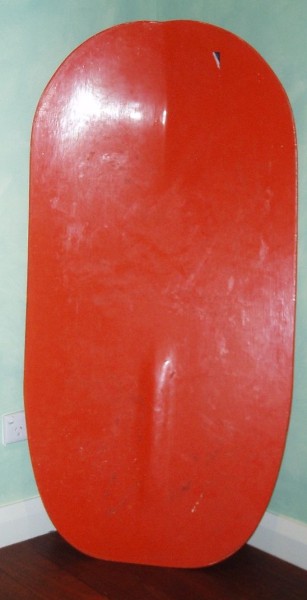
|
|

|
Photo by Henry Marfleet and courtesy Currumbin Surf Museum/Carl Tanner
collection.
13. I'll send you some links to other ply bellyboards.
Did they have a curve in them? The reason we
had a curve in it was that it didn't nosedive. If you nosedived on the
reef you were ratshit. The handlebars were mounted on the curved bit.
I don't know what happened to my board. When you leave home parents
tend to throw things out. I'd like to see young kids making their own
boards.
14. What did you enjoy about the bellyboard?
The fact that you could plane on them. The aim
of the thing was to get a beacher, pick up a wave out the back and get
into shore. If you achieved that it was a beacher. We used to do this
on the body but the board made it even easier. This made it even more
exciting as you were closer on the reef.
Western Australia is subjected to the south-westerly winds that blow
during the summer. That's when we were on the reef. The swell would be
coming from the south-west. You could stand on the reef and when the
wave came push off. It was good having the board because you could go
onto the reef and get them. They weren't huge waves but they were in
our minds.
Captain William Frazer Milne, Arctic whaler and
Peter's great grandfather.
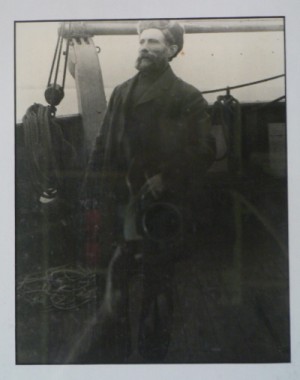
Photo courtesy Peter Kidman.
Note 1. Colin Vidler advised that Neville Kenyon and Don Vidler initially made the boards before Ron Vidler replaced Neville (Colin Vidler,
personal communication, November 29, 2010).
The boards were described by Vidler as transition boards between
rockerless bellyboards of the time and later kneeboards. These boards
were made in Scarborough, soaked in a swimming pool built by their
father in 1957. Colin advises that the boards were "Made of marine ply,
cut to shape, including a V cutout at front of board. The ply was then
submerged in water for a couple of days (parents swimming pool) and
then clamped to one half of a plough disk to obtain the "spoon" and
left clamped a few days. The V was then filled in with, I think, foam
and was then glassed so as to retain the spoon. Boards then sanded and
sprayed with Estapol. They were heavy but they used to go pretty good
and fast". The boards were manufactured over a four-five year period,
from the late 1960s to the early 1970s. Colin noted the boards were
made "so they could buy a Kombi (of course) deck it out and do the East
coast surf trip, before getting regular jobs. Ken, Colin and Jeff
Vidler won Australian lifesaving titles in ski events while Ken was a
1980 Moscow Olympian (Galton 1984).
Sources for Note 1:
- Vidler, Colin. E-mail correspondence of November 29, 2010.
- Galton, B. (1984). Gladiators of the Surf. The Australian Surf Life Saving Championships - A History. Frenchs Forest, AH & AW Reed.
|
|